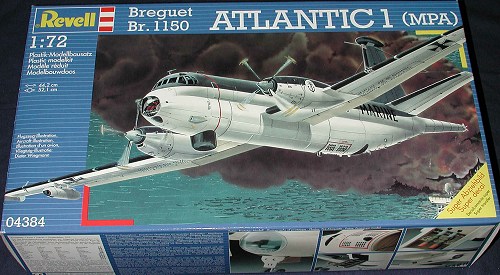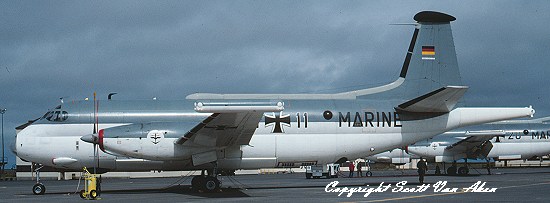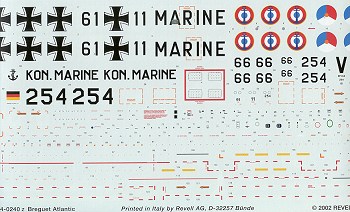
| KIT: | Revell AG 1/72 Breguet Atlantic |
| KIT # | 04384 |
| PRICE: | $22.00 MSRP |
| DECALS: | Three options |
| REVIEWER: | Scott Van Aken |
| NOTES: |

| HISTORY |
The first aircraft were delivered in 1965 to France and Germany, with Netherlands and Italy getting theirs soon afterward. Some were later sold to Pakistan. The production line was closed in 1973 as the nearly 90 aircraft had been delivered. The French later upgraded most of their remaining airframes to Atlantic 2 starting in 1988, but by 1997, this modification had been completed. Today, only the Dutch do not fly the Atlantic, having traded theirs in on the P-3 Orion during the mid 1980s.
remaining airframes to Atlantic 2 starting in 1988, but by 1997, this modification had been completed. Today, only the Dutch do not fly the Atlantic, having traded theirs in on the P-3 Orion during the mid 1980s.
When posted to Iceland in the late 1980s, German and French Atlantics were a common sight on the ramps as shown by this photo of one of the decal options. I should mention that the red items behind the props are engine covers. You'll also note that the upper dorsal spine is a lighter grey than the rest of the aircraft.
| THE KIT |
Couple of things about this kit. First of all, I can't understand why it took so long for it to finally appear here in the US. This kit has been available in Europe for at least five months before the importers finally decided to trickle a few over to this side of the pond. Yeah, it is an odd-ball European patrol aircraft, but there are a lot of people over here who LIKE odd-ball European patrol aircraft. Secondly, I'm not sure how Revell AG is making any money on these as $22.00 is dirt cheap for a kit of this complexity and quality. Were this to be done by Revell USA or Hasegawa, it would have been closer to $50. Same for the short run folks, who probably wouldn't touch something this size. The incredibly horrible Mach 2 kit of this plane sold for nearly $75.
Well, it is here now and I'm pretty amazed at it. I'm sure that many of you are thinking that a preview is a bit of a waste at this stage, but I forked over the funds and I'm a-gonna preview it!
Because of the sheer size of it, there won't be any photo of the 232 pieces that make up this kit. I can tell you that the detailing is engraved and very well done. I can also tell you that the decal sheet is very comprehensive and is too large to completely fit onto the platen of my flatbed scanner. They are also dated 2002 so this is a kit that has been in the works for quite a while.
Due to either the lack of mold space or because there is going to be other variants (like the NG), the fuselage is in three sections. The forward nose, most of the main fuselage, and the MAD boom. The white plastic sprues are packed into two bags, but packed rather tightly so that does help minimize shipping damage.
The kit comes with a full bomb bay and the weapons to put into them. Cockpit is quite complete with seats, consoles rudder pedals and all that. There are decals for the instruments, thought there is also raised detail if you wish to paint them. Because of the glass nose and the observers position, it will be difficult to find a place for nose weight and this one will definitely need it. Instructions show 30 grammes and that is a lot. It also shows it going into the area above the bomb bay. Those that don't want to mess with all the stuff in the bay can glue the doors closes. In my experience, they were usually closed. The kit also allows for thread (for the HF antennas) to be run from inside many of the parts before they are glued together. A nice touch, though I think most of us will want to use sprue towards the end of the build as the thread will just make painting that much more difficult.
There are different equipment options depending on whether you are building a Dutch, French or German plane. These include various pods and aft fuselage options. You can also build the plane gear up, but you'll have to come up with your own display stand as none is supplied. The landing gear is particularly complex looking and will be interesting to build as it has a lot of finely molded parts, several of which have some large areas of flash to be removed. Weapons of the bomb bay include torpedoes and depth bombs. One also has the option of having the crew entry hatch open or closed and to have the speed brakes deployed or not. The canopy may also cause some concern as it is split in left and right sides, making fixing the seam in the middle a bit of a challenge.
Instructions are typical pictogram versions and are very clearly done. Markings are for three different Atlantics. One is for the Dutch Navy, one for the French Navy and one for the German Navy. The sheet is well printed and matte with some of the decals having large areas of carrier on the inside of them. My experience with Revell decals is mixed as they seem to fit well, but are a bit thick and prone to silvering. Several readers have pointed out to me that the anchors on the French insignia are not the proper black color. Those having access to the Modeldecal sheet that includes French roundels will find some replacements for these, or you can ignore the glitch. There are undoubtedly other sources for Aeronavale insignia that I've missed. I understand that both ModelArt and Dutch Decals have some schemes for this kit if you want to go aftermarket. Colors are given for Revell paints only and this means mixing 3 colors to get the upper surface grey. I really hate this as we can't get Revell paints here in the US and there is no reason not to at least give us an FS number or generic name.
For some more updated information, Pieter writes: "According to Schönfeld, Atlantics were officially painted according to NATO rules in Medium Sea Gray aka BS 687 (top) and white (below). He thinks Xtracolor X3 should be a good match for BS 687. However, on French Atlantics (and the 4 Dutch Atlantics that were directly transferred from the French navy to the Dutch navy) another color was used, "Gris blue Clair", which was more blue-ish. He used Xtracolor X396."
| CONCLUSIONS |
Again, Revell AG shows us that what we never thought we'd see in mainstream kit form has come to pass. I can only hope that you'll all go out and buy one so they will keep up the good work. One thing for sure, if you like them big, then you'll like this one!
Kit courtesy of ME!!
If you would like your product reviewed fairly and fairly quickly by asite that has nearly 250,000 visitors a month, please contactme or see other details in the